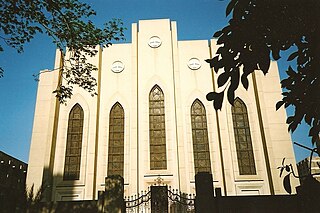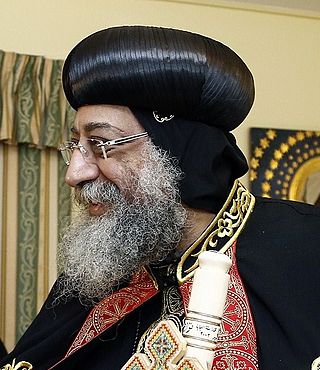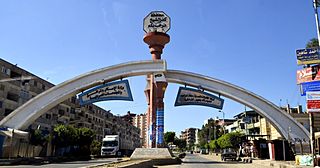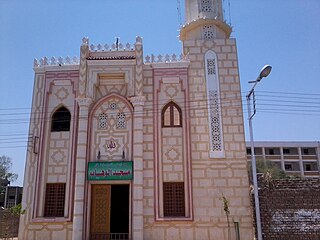
The Egyptian language, or Ancient Egyptian, is an extinct branch of the Afro-Asiatic languages that was spoken in ancient Egypt. It is known today from a large corpus of surviving texts, which were made accessible to the modern world following the decipherment of the ancient Egyptian scripts in the early 19th century.

Coptic is a group of closely related Egyptian dialects, representing the most recent developments of the Egyptian language, and historically spoken by the Copts, starting from the third century AD in Roman Egypt. It was commonly spoken until at least the 16th century when it was completely replaced by the Arabic language under the Mamluk Sultanate. Coptic has no native speakers today, although it remains in daily use as the liturgical language of the Coptic Orthodox Church and of the Coptic Catholic Church. Innovations in grammar and phonology and the influx of Greek loanwords distinguish Coptic from earlier periods of the Egyptian language. It is written with the Coptic alphabet, a modified form of the Greek alphabet with several additional letters borrowed from the Demotic Egyptian script.

Zagazig is a city in Egypt. Situated in the eastern part of the Nile delta, it is the capital of the governorate of Sharqia.

The Coptic Catholic Church is an Eastern Catholic particular Church in full communion with the Catholic Church. Along with the Ethiopian Catholic Church and Eritrean Catholic Church, it belongs to the Alexandrian liturgical tradition. Uniquely among the Alexandrian Rite Eastern Catholic liturgies, the Coptic Catholic Church uses the Coptic Rite and the Coptic language in its liturgy; the Ethiopian Catholic Church and Eritrean Catholic Church use the Ge'ez Rite.

Coptology is the scientific study of the Coptic people.

Severus ibn al-Muqaffaʿ or Severus of El Ashmunein was a Coptic Orthodox Bishop, author and historian. In Arabic, his name is spelled Sawires ساويرس. Severus is sometimes confused with the Persian author Abdullah ibn al-Muqaffa'.

Egyptian Arabic, locally known as Colloquial Egyptian, or simply Masri (مَصرى), is the most widely spoken vernacular Arabic variety in Egypt. It is part of the Afro-Asiatic language family, and originated in the Nile Delta in Lower Egypt. The estimated 100 million Egyptians speak a continuum of dialects, among which Cairene is the most prominent. It is also understood across most of the Arabic-speaking countries due to broad Egyptian influence in the region, including through Egyptian cinema and Egyptian music. These factors help to make it the most widely spoken and by far the most widely studied variety of Arabic.

Coptic music is the music sung and played in the Coptic Orthodox Church and the Coptic Catholic Church. It consists mainly of chanted hymns in rhythm with instruments such as cymbals and the triangle. Coptic music is purely religious.

The Pope, also known as the Bishop of Alexandria, or Patriarch of Alexandria, is the leader of the Coptic Orthodox Church, with ancient Christian roots in Egypt. The primacy of the Patriarch of Alexandria is rooted in his role as successor to Saint Mark, who was consecrated by Saint Peter, as affirmed by the Council of Nicaea. It is one of three Peterine Sees affirmed by the council alongside the Patriarch of Antioch and the Patriarch of Rome. The current holder of this position is Pope Tawadros II, who was selected as the 118th pope on November 18, 2012.

Samannud is a city (markaz) located in Gharbia Governorate, Egypt. Known in classical antiquity as Sebennytos, Samannud is a historic city that has been inhabited since the Ancient Egyptian period. As of 2019, the population of the markaz of Samannud was estimated to be 410,388, with 83,417 people living in urban areas and 326,971 in rural areas.
Ain Shams is a district in the Eastern Area of Cairo, Egypt. The name means "Eye of the Sun" in Arabic, referring to the fact that the district contained the ruins of the ancient city of Heliopolis, once the spiritual centre of ancient Egyptian sun-worship, and settled since 3100 BCE following the Predynastic Period. However, administratively the visible ruins today lie in the district of al-Matariya.

Sakha, also known by the ancient name of Xois is a town in Kafr El Sheikh Governorate of Egypt. Located near the center of the Nile Delta, it is a city of great antiquity, identified with the ancient Egyptian city of Ḫꜣsww(t).
Atfih is a town in Middle Egypt. It was part of the now defunct Helwan Governorate from April 2008 to April 2011, after which it was reincorporated into the Giza Governorate. As of 2001, it has a population of 106,300 inhabitants.
Qus is a city in the modern Qena Governorate, Egypt, located on the east bank of the Nile.

El Maragha is a city in the Sohag Governorate in Upper Egypt. It is located on the west bank of the Nile.

Babylon Fortress is an Ancient Roman fortress on the eastern bank of the Nile Delta, located in the area known today as Old Cairo or Coptic Cairo. The fortress was built circa 300 AD by Emperor Diocletian in order to protect the entrance to an ancient canal, previously rebuilt by Trajan, that linked the Nile with the Red Sea.
Henry Tattam was a Church of England clergyman and Coptic scholar.

Claudius Iohannes Labib was a Coptic (Egyptian) Egyptologist. His family was known for copying church books. He used to accompany his father to the el-Muharraq monastery to learn Coptic with the monks. He was the youngest of three brothers, the eldest being Pahor and the middle being Tadros. Labib learned Egyptian hieroglyphs from the French Egyptologists and was the second modern Egyptian to learn this ancient language. Claudius Labib is credited for making the first Coptic-Arabic Dictionary. He died before finishing it. Claudius Labib was the chief editor of "On" magazine which had articles written in Coptic. He also pioneered educational books for children named ⲁϧⲱⲙⲫⲁⲧ (Akhomphat).
Dalga is a town of about 120,000 people in Minya Governorate in Egypt. About 20,000 Christians live there.

Biba is a city in Beni Suef Governorate, Egypt. It contains a cathedral that dates back to the sixth century, although the building that stands today was built in the 19th century.














